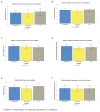Preschoolers Benefit Equally From Video Chat, Pseudo-Contingent Video, and Live Book Reading: Implications for Storytime During the Coronavirus Pandemic and Beyond
- PMID: 33013552
- PMCID: PMC7494800
- DOI: 10.3389/fpsyg.2020.02158
Preschoolers Benefit Equally From Video Chat, Pseudo-Contingent Video, and Live Book Reading: Implications for Storytime During the Coronavirus Pandemic and Beyond
Abstract
During the unprecedented coronavirus disease (COVID-19) crisis, virtual education activities have become more prevalent than ever. One activity that many families have incorporated into their routines while at home is virtual storytime, with teachers, grandparents, and other remote adults reading books to children over video chat. The current study asks how dialogic reading over video chat compares to more traditional forms of book reading in promoting story comprehension and vocabulary learning. Fifty-eight 4-year-olds (M age = 52.7, SD = 4.04, 31 girls) were randomly assigned to one of three conditions (Video chat, Live, and Prerecorded). Across conditions, children were read the same narrative storybook by a female experimenter who used the same 10 scripted dialogic reading prompts during book reading. In the Video chat (n = 21) and Live conditions (n = 18), the experimenter gave the scripted prompts and interacted naturally and contingently, responding in a timely, relevant manner to children's behaviors. In the Prerecorded condition (n = 19), children viewed a video of an experimenter reading the book. The Prerecorded condition was pseudo-contingent; the reader posed questions and paused for a set period of time as if to wait for a child's response. After reading, children completed measures of vocabulary and comprehension. Results revealed no differences between conditions across six different outcome measures, suggesting that children comprehended and learned from the story similarly across book formats. Further, children in the three experimental conditions scored significantly higher on measures than children in a fourth condition (control) who had never read the book, confirming that children learned from the three different book formats. However, children were more responsive to the prompts in the Live and Video chat conditions than the Prerecorded condition, suggesting that children recognized that these interactions were contingent with their responses, a feature that was lacking in the Prerecorded condition. Results indicate that children can comprehend books over video chat, suggesting that this technology is a viable option for reading to children, especially during the current pandemic.
Keywords: contingency; coronavirus disease; literacy; online learning; reading; video chat; vocabulary.
Copyright © 2020 Gaudreau, King, Dore, Puttre, Nichols, Hirsh-Pasek and Golinkoff.
Figures

Similar articles
-
Narrative comprehension and engagement with e-books vs. paper-books in autism spectrum condition.Autism Dev Lang Impair. 2020 Apr 14;5:2396941520917943. doi: 10.1177/2396941520917943. eCollection 2020 Jan-Dec. Autism Dev Lang Impair. 2020. PMID: 36381546 Free PMC article.
-
Embedding key word sign prompts in a shared book reading activity: The impact on communication between children with Down syndrome and their parents.Int J Lang Commun Disord. 2023 Jul-Aug;58(4):1029-1045. doi: 10.1111/1460-6984.12842. Epub 2022 Dec 31. Int J Lang Commun Disord. 2023. PMID: 36585887
-
Emergent literacy in print and electronic contexts: The influence of book type, narration source, and attention.J Exp Child Psychol. 2018 Sep;173:100-115. doi: 10.1016/j.jecp.2018.03.013. Epub 2018 Apr 24. J Exp Child Psychol. 2018. PMID: 29702378
-
The Impact of E-Book Reading on Young Children's Emergent Literacy Skills: An Analytical Review.Int J Environ Res Public Health. 2021 Jun 16;18(12):6510. doi: 10.3390/ijerph18126510. Int J Environ Res Public Health. 2021. PMID: 34208785 Free PMC article. Review.
-
The effects of shared storybook reading on word learning: A meta-analysis.Dev Psychol. 2018 Jul;54(7):1334-1346. doi: 10.1037/dev0000512. Epub 2018 Mar 29. Dev Psychol. 2018. PMID: 29595311 Review.
Cited by
-
Four-Year-Old's Online Versus Face-to-Face Word Learning via eBooks.Front Psychol. 2021 Mar 12;12:610975. doi: 10.3389/fpsyg.2021.610975. eCollection 2021. Front Psychol. 2021. PMID: 33776837 Free PMC article.
-
Family Factors Associated with Hands-On Play and Screen Time During the COVID-19 Pandemic.Child Youth Care Forum. 2022;51(6):1091-1115. doi: 10.1007/s10566-021-09668-4. Epub 2022 Jan 6. Child Youth Care Forum. 2022. PMID: 35013660 Free PMC article.
-
Reexamining models of early learning in the digital age: Applications for learning in the wild.J Appl Res Mem Cogn. 2023 Dec;12(4):457-472. doi: 10.1037/mac0000132. Epub 2023 Sep 4. J Appl Res Mem Cogn. 2023. PMID: 38223884 Free PMC article.
-
Screen time and early childhood development in Ceará, Brazil: a population-based study.BMC Public Health. 2021 Nov 11;21(1):2072. doi: 10.1186/s12889-021-12136-2. BMC Public Health. 2021. PMID: 34763693 Free PMC article.
-
Reducing harm and promoting positive media use strategies: new perspectives in understanding the impact of preschooler media use on health and development.Psicol Reflex Crit. 2023 Aug 9;36(1):19. doi: 10.1186/s41155-023-00262-2. Psicol Reflex Crit. 2023. PMID: 37553485 Free PMC article. Review.
References
-
- Aladé F., Lauricella A. R., Beaudoin-Ryan L., Wartella E. (2016). Measuring with Murray: touchscreen technology and preschoolers’ STEM learning. Comput. Hum. Behav. 62, 433–441. 10.1016/j.chb.2016.03.080 - DOI
-
- Ames M. G., Go J., Kaye J. J., Spasojevic M. (2010). “Making love in the network closet: the benefits and work of family video chat.” in Proceedings of the 2010 ACM Conference on Computer Supported Cooperative Work February 6–10, 2010. 145–154.
-
- Arnold D. H., Lonigan C. J., Whitehurst G. J., Epstein J. N. (1994). Accelerating language development through picture book reading: replication and extension to a videotape training format. J. Educ. Psychol. 86, 235–243. 10.1037/0022-0663.86.2.235 - DOI
-
- Arnold D. S., Whitehurst G. J. (1994). “Accelerating language development through picture book reading: a summary of dialogic reading and its effect” in Bridges to literacy: Children, families, and schools. ed. Dickinson D. K. Blackwell Publishing, 103–128.
-
- Ballagas R., Kaye J. J., Ames M., Go J., Raffle H. (2009). “Family communication: phone conversations with children” in Proceedings of the 8th International Conference on Interaction Design and Children June 3–5, 2009. 321–324.
LinkOut - more resources
Full Text Sources

